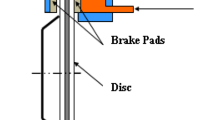Abstract
In the process of developing the brake disc, it is necessary that we predict the suitability of the design. In this manner, we can affirm that even the first prototype will satisfy all of the customer homologation requests. Usually those comprise different sequential braking tests in which the maximal achieved temperature is the criterion that governs brake disc suitability. The knowledge of how to predict the behavior of a brake disc in the early pretesting phase has a significant impact on development costs and time. The common method that is used for predicting the temperatures in the brake disc during braking is numerical simulation analysis. With the help of Computational Fluid Dynamics, the flow through a vehicle ventilated brake disc of known geometry was determined, and the wall heat transfer coefficients for all vehicle speeds and brake disc temperatures were calculated. The results were then imported into a thermal numerical simulation of a sequential-braking vehicle test. The results showed that the consideration of cooling factors has a significant impact on temperature courses. To obtain accurate results from the numerical simulation and to simulate the vehicle test precisely, the proper wall heat transfer coefficients must be considered. The proposed method produces more accurate numerical results and enables the development engineer to develop suitable brake disc geometry in the early pretesting phase.
Similar content being viewed by others
References
ANSYS (2009). ANSYS CFX, Release 12.0. User’s Guide. Solver Theory Guide — Modeling Flow Near Wall — GGI and MFR Theory.
Chi, Z. (2008). Thermal Performance Analysis and Geometrical Optimization of Automotive Rake Rotors. M.S. Thesis. University of Ontario Institute of Technology.
Cimos Developlent Group (2009). Brake and Suspension. Brake Disc Manual Cimos Internal Brake Disc Development Manual. Cimos d.d. Automotive Industry, Maribor. Slovenia.
Dassault Systemes (2008). Software Package ABAQUS CAE 6.9. User’s Guide.
ESSE (2005). AMS (Auto-Motor-Sport) Brake Test. Corporate Engineering Test Procedure. CETP:-06.00-R-408 200510. Engineering Standards & Systems Engineering.
Galindo-Lopez, C. H. and Tirovic, M. (2008). Understanding and improving the convective cooling of brake disc with radial vanes. Proc. Institution of Mechanical Engineers, Part D: J. Automobile Engineering 222,7, 1211–1229.
Gotowicki, P. F., Nigrelli, V., Mariotti, G. V., Aleksadric, D. and Duboka, C. (2005). Numerical and experimental analysis of a pegs-wing ventilated discs brake rotor, with pads and cylinders. Beograd 2005 EAEC European Automotive Cong., JUMV, Paper EAEC05YU-AS04.
Limpert, R. (1975). The thermal performance of automotive disc brakes. SAE Paper No. 750873.
Palmer, E., Mishra, R. and Fieldhouse, J. (2009). An optimization study of a multiple row pin vented brake disc to promote brake cooling using computational fluid dynamics. Proc. Institution of Mechanical Engineers, Part D: J. Automobile Engineering, 222, 865–875.
Reibenschuh, M. and Oder, G. (2009). Modeling and analysis of thermal and stress loads in train disc brakes — braking from 250km/h to standstill. Strojniški Vestnik — J. Mechanical Engineering 55,7–8, 494–502.
Yildiz, Y. and Duzgun, M. (2010). Stress analysis of ventilated brake disc using the finite element method. Int. J. Automotive Technology 11,1, 133–138.
Author information
Authors and Affiliations
Corresponding author
Rights and permissions
About this article
Cite this article
Pevec, M., Potrc, I., Bombek, G. et al. Prediction of the cooling factors of a vehicle brake disc and its influence on the results of a thermal numerical simulation. Int.J Automot. Technol. 13, 725–733 (2012). https://doi.org/10.1007/s12239-012-0071-y
Received:
Revised:
Accepted:
Published:
Issue Date:
DOI: https://doi.org/10.1007/s12239-012-0071-y




